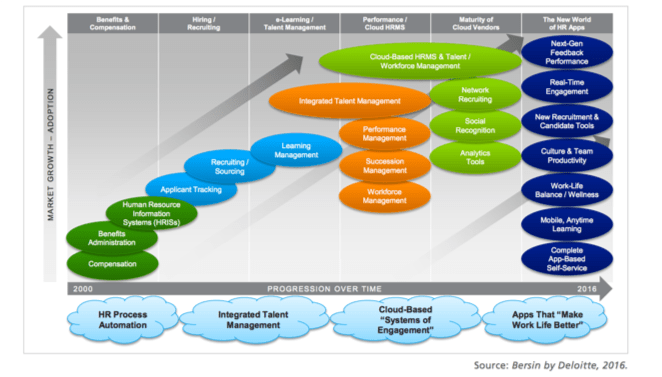The Evolution of HR Software
Bersin (by Deloitte) have a well- publicised model of how the HR software market has evolved over the past 20 years. It started with HR Process Automation, then Integrated Talent Management and the move to Cloud based ‘Software as a Service’. The recent explosion of ‘mobile Apps’ is arguably the greatest change of all, with rate of innovation accelerating leading to proliferation of choice.

Underpinning the latest market disruption are three major technology shifts: First is mobile – any device, any place, any time. This is about web based responsive design, meaning the same version of the software can work seamlessly on desktops, tablets and smart phones. There is no longer the need for complexity and cost of maintaining multiple mobile Apps for iOS, Android and Windows. Second is platform – layered flexible architectures fit for digital age. These are underpinned by a shared foundation layer or tool kit, on top of which the various product modules and features are built. A customer specific layer then enables a tailored solution and user experience. In addition to offering greater flexibility and choice, platform architectures are readily extensible, with reduced development costs and speed to market. Third is People Analytics – easy access to all data. Readily accessible data is the pre- requisite for the next big trend on ‘predictive’ analytics and readiness for artificial intelligence. Traditional HR data sets need to be combined with more socially oriented data sets relevant to employee engagement.

Stick, Twist or Bust?
For those in the hospitality sector, the choice is stark – ‘Stick’, ‘Twist’ or ‘Bust’.
- ‘Stick’ is staying with your legacy HR/Payroll solution, trusting that your provider will develop their product or acquire point solutions and integrate them over time.
- ‘Twist’ is taking the decision to supplement your legacy HR/Payroll solution with new point solutions, incorporating additional features but accepting higher costs and lack of integration.
- ‘Bust’ is the hard choice of accepting that your legacy HR/Payroll solution, likely developed in the era of HR process automation, is not fit for the digital age – and its time for change.At the heart of this debate, is the need for a better understanding on the trade-offs between single platforms versus multiple best in breed or integrated solutions. This is a hot topic – according to Bersin: “HR software buyers today want systems with fewer features and less complexity, not more. 47% of companies will replace their multiple HR systems with one unified solution. 67% will select this system based on east of use rather than quality of features”. So why is this?

Best in Breed / Integrated Solutions
Whilst it is always possible to find a best in breed solution with additional features, this normally comes at a cost. It can prove problematic (or impossible) to integrate with other systems, and difficult to access data. The user experience can also be great on one system, but overall engagement compromised as employees have multiple log-ins, undermining uptake for all but mandatory use.
As an alternative, many HR / Payroll vendors offer ‘Integrated’ solutions (not to be confused with ‘Single Platforms’). Integrated solutions tend to be a combination of yesterday’s market
leading best in breeds acquired by the HR / Payroll vendor to complete their product set, or in-house developments that layer a modern user experience or new features on top of dated software. Whilst this can consolidate vendor management, it is not without its own problems. The user experience is rarely seamless, and underneath the covers, a patchwork quilt of integrations increases maintenance costs, risks outages and limits data access. Over time, speed of innovation slows and costs increase, as development become harder. It can become a trap that is difficult to escape.

Single Platforms
The case for Single Platforms is compelling. You only have to look at synergies across the employee lifecycle to see how business needs can better met by combining features normally associated with different product sets. A single platform enables these features to be combined with a consistent user experience, whilst ensuring integrity of data.
To date, the hospitality sector has been poorly served, as single platforms that account for sector specific needs in engagement, workforce management and full suite HR/Payroll have not been available. This is about to change – the era of cloud based, single platform solutions has arrived.
Win / Win – in Bite Sized Chunks
For start-ups or smaller companies looking to invest in their first HR / Payroll solution, the choice is easy. There is no baggage, and the promise of a single platform fit for the digital age has huge appeal. For others it is not so simple. The case for change is usually driven by immediate business needs, each of which might be met by a ‘best in breed’ solution or the current HR / Payroll provider. Biting the bullet to partner with a Single Platform vendor may seem like an idea for the future.
The win / win of Single Platform solutions is that they are modular. This means that any transition can be broken down into bite-sized chunks, focusing on immediate business needs, whilst creating options to fill capability gaps or replace legacy systems over time. For larger corporates, it may start with a unifying engagement portal – providing a layer of user experience calm as legacy systems are replaced over time. For smaller / medium sized companies, it may start with specific needs in Recruitment or L&D, a productivity challenge requiring Workforce Management or a contract renewal prompting a review of HR / Payroll. Whatever the trigger, the time is right to consider single platforms – putting the employee first and joining up the employee lifec




